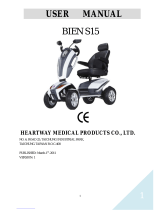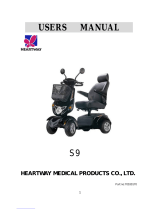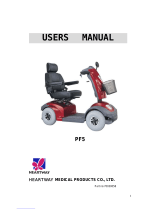Page is loading ...

1
USERS MANUAL
HEARTWAY MEDICAL PRODUCTS CO., LTD.
NO. 6, ROAD 25, TAICHUNG INDUSTRIAL PARK,
TAICHUNG. TAIWAN R.O.C.408
PUBLISHED: AUG. 3, 2009
VERSION: 1 Part no:
70030175
S12 VITA

2
CONTENTS
1.
2.
SAFETY INSTRUCTION…………………………………...……………................................…3
3.
ELECTOMAGNETIC INTERFERENCE(EMI)…………….…………………………………6
4.
SPECIFICATIONS………………………….………………..……………….…………………..8
5.
COMFORT ADJUSTMENT……………………….…………………………..…………..9
6.
OPERATION OF CONTROL PANEL…………………………………………………………12
7.
CHARGING INSTRUCTION….……………………………..………….……………………..23
8.
BATTERY INSTRUCTION & MAINTENANCE…………...………………………….…..…26
9.
SCOOTER MAINTENANCE & REPAIR…..…………...………………….………..……..…27
10.
TROUBLESHOOTING & FAULT REPAIR……….………..…………………………………29
11.
CIRCUIT DIAGRAM…….………..…….……..………………………..………………………31
12.
HEARTWAY’S PATENT-SUSPENSION SYSTEM…….……………………………….…….31
13.
BOM LIST DRAWING………………............…………………….………….…………………32
WARRANTY DECLARATION…………………………………………………………………33

3
SAFETY INSTRUCTION
General
Always use a seat belt, and keep your feet on the scooter
all the time.
Never operate the scooter while you are under the
influence of alcohol.
Never use electronic radio transmitters such as
walkie-talkies, or cellular phones.
Make sure that there are no obstacles behind you while
reserving your scooter.
Do not make a sharp turn or a sudden stop while riding
your scooter.
Do not rider your scooter in traffic.

4
Do not attempt to climb curbs greater than limitation
show on Technical Specification
Do not leave your hands and legs off the scooter when
driving.
Do not rider your scooter during snow in order to avoid
accident on slippery road.
Do not allow unsupervised children to play near this
equipment while the batteries are charging.
Warning
1. To prevent injury to yourself or others, always ensure that the power is switched off when getting on or
off of the scooter.
2. Always check that the drive wheels are engaged (drive mode) before driving. Do not switch off the power
when the scooter is still moving forward. This will bring the chair to an extremely abrupt stop.
3. Do not use this product or any available optional equipment without first completely reading and
understanding these instructions. If you are unable to understand the warnings, cautions or instructions,
contact a healthcare professional, the dealers or technical supports before attempting to use this equipment,
otherwise, injury or damage may occur.
4. There are certain situations, including some medical conditions, where the scooter user will need to
practice operating the scooter in the presence of a trained attendant. A trained attendant can be defined as
a family member or care professional especially trained in assisting a scooter user in various daily living
activities. Consult with your physician if you are taking any medication that may affect your ability to
operate your scooter safely.
5. Do not attempt to lift or move a power scooter by any of its removable parts including the armrests, seats
or shrouds. Personal injury and damage to the power chair may result.
6. Never try to use your scooter beyond its limitations as described in this manual.

5
Modifications
Heartway Medical Product has designed and engineered power scooters to provide maximum utility. However,
under no circumstances should you modify, add, remove, or disable any part or function of your power scooter.
Personal injury and damage to the power chair may result.
1. Do not modify your power scooter in any way not authorized by Heartway. Do not use accessories if they
have not been tested or approved for Heartway products.
2. Get to know the feel of your power scooter and its capabilities. Heartway recommends that you perform a
safety check before each use to make sure your scooter operates safely.
Inspections prior to using your power scooter:
1. If equipped with pneumatic tires, please check for proper tire inflations.
2. Please check all electrical connections and make sure they are tight and not corroded.
3. Please check all harness connections and make sure they are secured properly.
4. Please check the brakes.
Weight limitation.
1. Please refer to the specifications table for weight capacity information. Power scooter is rated for a
maximum weight capacity.
2. Stay within the specified weight capacity for your scooter. Exceeding the weight capacity voids your
warranty. Heartway will not be held responsible for injuries or property damage resulting from failure to
observe weight limitations.
Tire inflation
1. If your scooter is equipped with pneumatic tires, it is necessary to check the air pressure at least one time a
week.
2. Proper inflation pressures will prolong the life your tires and ensure the smooth operation while riding.
3. Do not under-inflate or over-inflate your tires. It is critically important that 30-25 psi (2-2.4bar) tire
pressure be maintained in pneumatic tires at all times.
4. Inflating your tires from an unregulated air source could over-inflate them, resulting in a burs tire.
Temperature
1. Some of the parts of the power scooter are susceptible to change in temperature. The controller can only
operate in temperature that ranges between -25℃ ~ 50℃.
2. At extreme low temperatures, the batteries may freeze, and your power scooter may not be able to operate.
In extreme high temperatures, it may operate at slower speeds due to a safety feature of the controller that
prevents damage to the motors and other electrical components.

6
ELECTROMAGNETIC INTERFERENCE (EMI)
The rapid development of electronics, especially in the area of communications, has saturated our environment
with electromagnetic (EM) radio waves that are emitted by television, radio and communication signals. These
EM wave are invisible and their strength increases as one approach the source. All electrical conductors act as
antennas to the EM signals and, to varying degrees, all power wheelchairs and scooters are susceptible to
electromagnetic interference (EMI). The interference could result in abnormal, unintentional movement and/or
erratic control of the vehicle. The United States Food and drug Administration (FDA) suggests that the
following statement be incorporated to the user’s manual for all power scooter like the S12
1. Do not turn on hand-held personal communication devices such as citizens band (CB) radios and cellular
phones while the powered scooter is turned on.
. Power scooters
may as susceptible to electromagnetic interference (EMI), which is interfering electromagnetic energy emitted
from sources such as radio stations, TV stations, amateur radio (HAN) transmitter, two-way radios, cellular
phones and alarm systems of shops. The interference (from radio wave sources) can cause the power scooter to
release its brakes, move by itself or move in unintended directions. It can also permanently damage the
powered scooter’s control system. The intensity of the EM energy can be measured in volts per meter
(V/m).Each powered scooter can resist EMI up to a certain intensity. This is called “immunity level”. The
higher the immunity level the greater the protection. At this time, current technology is capable of providing at
least 20 V/m of immunity level, which would provide useful protection against common sources of radiated
EMI.
Following the warnings listed below should reduce the chance of unintended brake release or powered scooter
movement that could result in serious injury:
2. Be aware of nearby transmitters such as radio or TV stations and try to avoid coming close to them.
3. If unintended movement or brake release occurs, turn the powered scooter off as soon as it is safe.
4. Be aware that adding accessories or components, or modifying the powered scooter, may make it more
susceptible to interference from radio wave sources (Note: It is difficult to evaluate the effect on the
overall immunity of the powered scooter).
5. Report all incidents of unintended movement or brake release to the powered scooter manufacturer, and
note whether there is a radio wave source nearby.

7
TURN OFF YOUR POWERED SCOOTER AS SOON AS POSSIBLE WHEN EXPERIENCING THE
FOLLOWING:
Unintentional scooter movements
Unintended or uncontrollable direction.
Unexpected brake release
The FDA has written to the manufacturers of power scooters asking them to test new products to be sure they
provide a reasonable degree of immunity against EMI. The FDA requires that a powered wheelchair should
have an immunity level at least 20 V/m, which provides a reasonable degree of protection against more
common sources of EMI. The higher the immunity level the greater the protection. Your powered scooter has
an immunity level of 20 V/m which should protect against common sources of EMI. Warning: The scooter
itself can disturb the performance of the electromagnetic fields such as emitted by alarm systems of shops.

8
TECHNICAL SPECIFICATIONS
MODEL S12
WEIGHT CAPACITY 160kgs(350 lbs)
SEAT: TYPE/SIZE 20" A2
DRIVE WHEEL 330mmx120mm(13" x 5")
FRONT CASTER (WHEEL) 330mmx100mm(13" x 3.5")
REAR CASTER (ANTI-TIPPER) None
MAX SPEED 15KPH (9.3MPH); Opt: (+/-)20KPH (12.4MPH)
BATTERY SPECIFICATIONS 12V 62Ah x 2pcs; Opt:80Ah
BATTERY RANGE 45km
CHARGER TYPE (240 V for Europe) 8 Amp, Off Board (240 V for Europe)
CONTROLLER TYPE Dynamic Rhino 110Amp
MOTOR TYPE 4400rpm 700W
WEIGHT: W/ BATTERY 100kgs(220 lbs)
WEIGHT: W/O BATTERY 72kgs(158 lbs)
TURNING RADIUS 1280mm
SUSPENSION FULL
LENGTH 1400mm
WIDE 700mm
HEIGHT 1360mm
SEAT WIDTH 510mm
SEAT HEIGHT 460mm
SEAT DEPTH 480mm
BACK HEIGHT 750mm
WHEEL BASE 1025mm
GROUND CLEARANCE 80mm
LEG ROOM 320mm

9
COMFORT ADJUSTMENT
Adjustments for Seating Comfort:
Press the bottom to adjust
the height of the headrest.
Adjust the seat back lever
for seating back angle.
The flip-up armrest
height can be adjusted
by turning the
adjustment dial.
Turn the swivel lever downwards to rotate the seat.
Push the front lever upwards to move the seat forward
and backward.

10
Driving and braking
→For Driving please pull the right throttle lever (forward) or the left throttle lever (rearward).
→Please release the throttle lever to stop the scooter. In the center position the magnetic motor brake
system works also as a parking brake. Optional there is a hand brake system available.
→For safety, when rolling at free-wheel mode down slope, the automatic brake will take action if the
transferring speed is more than 30% of the scooter’s maximum speed.
Forward Reverse
Optional hand brake lever
Disengaged
(Free Wheel)
Engaged Please be noted that the scooter will be at free-wheel
mode, when the motor is disengaged.
To use the parking brake, you must move and lock the
lever into the engaged position!

11
2.4 Tiller Positioning
Press down the lever and move it to your preferred position.
2.6 The adjustment of the suspension system:
The softness of the rear suspension system can be
adjustable. There are altogether 5 stages of adjustment.
Tooling bar

12
OPERATION OF CONTROL PANEL
LCD(Liquid Crystal Display)Power Scooter Control Panel, TN Type
Model LCD(Liquid Crystal Display)
Functions 1. Power Indicator:Battery remaining capacity and charging indicator (6 squares + Battery Icon)
2. Clock:Hour / Minute / Second display and setting.
3. Speed Sensor:7 Segment display (2.5 digits +1 decimal) + “km/h / mph” symbol
4. High/Low/ Turn Speed:Indicated as “H” and “L” symbols
5. Odometer:ODO(99999km max)、TRIP(99.9 max)
6. Headlight:“Power-saving” mode, Blue LED
7. Back-up Lamps:“Brake / Reverse” modes, Orange LED
8. Right-Indicator:Flash mode, Green LED
9. Left-Indicator:Flash mode, Green LED
10. Parking Lamp:Including “Reverse Mode”, left- indicator and right-indicator flashing
simultaneously, Red LED
11. Malfunction Code:7 Segment display (1digit ) + Warning symbol + Red LED
12. Power-on Scan:All LED turn on
13. TEMP Gauge:ºC and ºF modes
14. Reverse Light: ”Reverse” symbol flashing
Buttons :Left-Indicator control :Right-Indicator control
:High/low speed switch :Parking

13
Buttons :Horn :Horn
:Headlight :MODE :SET :Back-up Light
LED Indicators Right & Left indicator (Green) ,Parking light (Red),Warning light (Red),Back-up lamps (Yellow)
,
Headlight (Blue)
LCD Backlight LED (White)
Connector CON1: 20PIN AMP
Usage Condition
ITEM SPECIFICATION
Voltage DC24 V
Operation Voltage DC 16 ~32 V
Storage TEMP. -40℃ ~ 65℃
Operation TEMP. -25℃ ~ 50℃
Meter Angle at
Handle Cover
30° of elevation while scooter assembly (LCD orientate to six o’clock)
2、General Characteristic Performance Test (20 ± 5℃)
2.1、Headware Circuit:
ITEM SPECIFICATION RESULT
Lowest Operation VOLT 16 V max
V
Consuming Current
(VB
Dynamic: 200 mA max
-- Backlight and LED light status
Static: 5 mA max
-- Key OFF status
= 24.0V)
mA
mA

14
Operating Instruction
1、Speed Sensor and Display
ITEM SPECIFICATION
Operation Features Speed detection by speed sensor from transaxle with conversion at 1800rpm equal to
60km/h.
Tolerance 5~15% (±2%)
Digital Range 0.0 ~ 99
Display Switch Button Initial setting at km/h, switch to MPH by MODE and SET buttons
2、High / Low / Turn Speed
ITEM SPECIFICATION
Operation Features
(1) Switch High / Low speed by pressing button once. (TRN as control signals) Press
one time: High-speed <<--->> Low-speed (with memory storage).
(2) Take exterior turn-switch as determinant signal (TRN as control signals).
Symbols on LCD "H"symbol means “High Speed”
"L"symbol means “Low Speed”:
"L"symbol flashing means “Turn Speed”:
Flicker Frequency 1 sec

15
3、Power Indication
ITEM SPECIFICATION
Battery Remaining
Capacity
Remaining Capacity
(%) Voltage (V) Scale Bar
100
(6) > 25.42
85
(5) ≦ 25.42
70
(4) ≦ 25.12
55
(3) ≦ 24.78
40
(2) ≦ 24.42
30
(1) ≦ 23.88
and Flashing
20 Low-power
Warning Warning LED Flashing
Flicker Frequency 2 sec.
Operation Characters
(1) Scale status only decrease, won’t increase.
(2) When the remaining capacity was less than 30%, warning sound (“Be-Be” two short sounds)
act at 5 seconds intervals.
While (a) Key Off (b) Charging Mode (c) Sleep Mode, warning sound released.

16
ITEM SPECIFICATION
Charge Indication
Remaining
Capacity (%) Voltage (V) Scale Bar
40
(2)
< 25.44
55
(3) > 25.44
70
(4) > 26.18
80
(5) > 26.92
90
(6) > 28.5
100
(7)
Increase
Frequency 0.5 sec.
Operation
Character
(1) Scale status only decrease, won’t increase.
(2) Take the PIN3(CH3) of charger as determinant signal, enter「Charging Mode」when CH3
grounding (L), not only “KEY ON” or “KEY OFF”.
Remarks Above scale bar status only for reference, must take the indicator of charger as the precise
diagnosis.

17
4、Clock Meter
ITEM SPECIFICATION
Tolerance (per day) ± 2 sec
Initial Setting Value
『
Hour
:
Min
』
mode :
『
AM 12:00
』
『Hour : Min』
Setting
(12-Hour format)
Display range : AM12:00 ~ PM11:59
When
『
Hour
』
is between 1 and 9 o’clock, displayed at 1~9.
5、Odometer
ITEM SPECIFICATION
Operation Features Odometer detected by the signal of Opto Coupler then converts into distance.
Display Switch Button 「km/h」 means the odometer displayed as kilometer.
「mph」 means the odometer displayed as mile.
Accumulative Display
[ODO]
(1) Display Range:00000~99999
(2) Once the total mileage up to 99999km or 62149mile (99999÷1.609mile), the counter will
restart from “00000”.
TRIP Counter
(1) Display Range:00.0~99.9
(2) When over 99.9km, display stop counting
(won’t restart from “00.0”).
Operation status (1) Odometer indication display on ODO mode when Power On, then switch to TRIP mode
after 5 seconds.
(2) TRIP can be reset to “00.0”.

18
6、Headlight Control
ITEM SPECIFICATION
Operation Feature
Take exterior headlight switch as determinant signal.
(1) Switch on/off the head light by pressing button once, then LED will turn
on/off simultaneously.
(2) LCD backlights turn on / turn off with head light.
Power Saving Mode When motor stop, the modulation down to 30% (Headlight)
When motor act, 100% output power (Headlight)
Usage Condition While (a) KEY OFF (b) Power-Saving mode (c) Sleep mode, all functions closed.
Determinant
Condition
(1) 2.2V>WIP>2.8V ( 100% Full-power )
(2) 2.2V<WIP>2.8V ( 100% Full-power )
(3) Full / Half power switch at real time.
(4) The determination of “Reversing Mode” need to consider the motor direction and panel
setting.
Remarks (1) Loop Load: 24V/50W max
(2) With “short circuit” and “overload” protection
7、Back-up Lamp control
ITEM SPECIFICATION
Operation Feature
Take exterior back-up lamp switch as determinant signal.
(1) Switch on/off the head light by pressing button once, then LED will
turn on/off simultaneously.
(2) LCD backlights turn on / turn off with head light.
(Control Mode)
Brake-lamp Mode
Reversing-lamp Mode
When motor changes from act (go forward) to stop, the lamp reinstated after flashing
for 3 sec.
Determine as “Reversing Mode”, back-up lamp keep flashing.
Reverse warning sound can be set by panel ( Turn on / Turn off)
Usage Condition While (a) KEY OFF (b) Charging Mode (c) Sleep Mode, all functions closed.
* Brake-lamp & Reversing-lamp Mode won’t be limited by Back-up lamp switch on or
off.
Flicker Frequency 1 sec.

19
ITEM SPECIFICATION
Determinant Condition
(1) 2.2V>WIP>2.8V ( 50% Half-power )
(2) 2.2V<WIP>2.8V ( 100% Full-power )
(3) Full / Half power switch at real time.
(4) The determination of “Reversing Mode” need to consider the motor direction and
panel setting.
Remarks (1) Loop Load : 24V/50W max
(2) With “short circuit” and “overload” protection
8、9、10 Indicators and Parking Lamp Control
ITEM SPECIFICATION
Operation Feature Take exterior left-right indicators and parking-lamps switch as the determinant signal.
Control Mode
(Left-direction lamp)
(Right-direction lamp)
(Parking lamp)
Press button once, the right-indicator and turn off, left-indicator and
flashing, warning sound act. Press again to turn off left-indicator.
Press button once, the right-indicator and turn off, left-indicator and
flashing, warning sound act. Press again to turn off left-indicator.
Press button once, turn on, right-left indicators and flashing ,
warning sound act . Press again to turn off the Parking lamp function.
Usage Condition While (a) KEY OFF (b) Charging Mode (c) Sleep Mode, all functions closed.
Flicker Frequency 1 sec.
Warning Sound Frequency One short “Bi” sound per second
Remarks (1) Load circuit for left-direction light: 24V/50W max
(2) Load circuit for right-direction light: 24V/50W max
(3) With “short circuit” and “overload” protection

20
11、Malfunction Message
ITEM SPECIFICATION
Operation Feature Take the connector pin (KEY) of controller as determinant signal, then converts it into
digital code.
Usage Condition
When the controller send out an error message, red LED flashing with controller signal at
same time, the “Error message code” will show on LCD.
Flicker Frequency 1 sec.
Controller
message
(Flicker)
Message
code
symbol
LED
(Flicker) Status
1
--
--
Flashing,
opposite to
controller
message.
Battery needs charge soon.
2
2
On
Low-voltage, needs charge now
3
3
On
Over-voltage
4
4
On
Over-current
5
5
On
Park Brake lost or faulted
6
6
On
Accelerator not align center
7
7
On
Accelerator broken or faulted
8
8
On
Motor broken or faulted
9
9
On
Others
/








